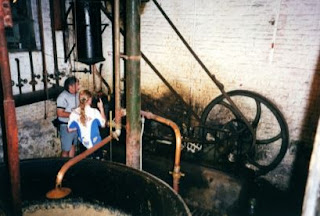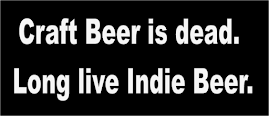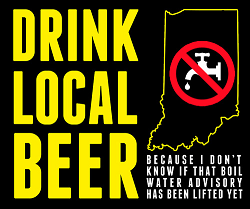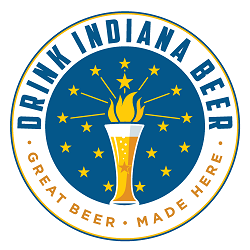As we rode our bikes down narrow Wallonian country lanes, not far removed from the outskirts of Tournai and our base camp at the Hotel d’Alcantara, a clear and warm summer Saturday afternoon suddenly turned blustery and overcast.
The Cochonette-laced warm fuzzies from a lengthy session at Brasserie à Vapeur on its monthly brewing day dissipated rapidly in the face of a brisk headwind, made more formidable by legs still tired from the previous day’s mountain biking excursion in the woods and fields of the Pays du Collines.
However, the sobering return workout was all for the best, because a taxing celebratory evening still lay ahead.
Awaiting our return at the hotel were the Three Danes of the Apocalypse: Kim Wiesener, Kim Andersen and Allan Gamborg. Coincidentally, they had gathered in Wallonia for the European football (soccer) championships being held in the summer of 2000 at various venues throughout Belgium and the Netherlands, and after being made aware of our beercycling visit, conspired to include us in the itinerary.
These three cosmopolitan natives of Denmark are bosom friends of long standing, each of them multilingual, well-traveled and professionally accomplished in his chosen field. When a football match is taking place, each of them also is prone to reverting with dazzling speed to a childlike state, one understood internationally and intuitively by all sporting males.
Their life stories would fill a volume, and such a biographical rendering lies beyond my immediate task of describing the 2000 beercycling trip, but according to tradition, I’m permitted one digression. Here it is, in one of several versions.
Back in the day …
----
My friendship with the Danes goes back to 1987, and is inexorably intertwined with that of my illustrious longtime partner in crime, Barrie Ottersbach, who was unable to join us in Tournai in 2000.
That fateful summer of ‘87, an unsuspecting Kim Wiesener was the tour leader for a “youth” travel group visiting the Soviet Union and Poland, and Barrie and I were enthusiastic and only marginally youthful participants (we were 27).
Legend has it that Kim fell under Barrie’s spell (or was it the other way around?) on a hair-raising Aeroflot flight from Copenhagen to Moscow, where I joyously met the group, having arrived in the capital of the evil empire by way of a 36-hour train trip from Hungary during which I was kept company by a bag of fresh cherries, two loaves of bread, a salami from Szeged and two bottles of Bull’s Blood wine.
On the morning following the boozy evening of the group’s belated arrival, all of us were supposed to meet in the hotel lobby before setting out for a bus tour of Moscow. Kim was mildly concerned when Barrie failed to appear for roll call; I reassured him that all was well, and that Barrie was in safe hands, having ventured into the Soviet underworld with “Bill,” the friendly neighborhood black market sales representative who I’d met earlier under similar circumstances.
At that point, and not even a full day into the excursion, Kim understood that it would be a long journey, but he was reassured when Barrie appeared later that afternoon brandishing a softball-sized wad of colorful rubles. For the remainder of our stay in the USSR, Barrie gleefully depleted the ridiculously huge bankroll on lavish restaurant meals, caviar, vodka and champagne; beer was difficult to find, and the rubles worthless elsewhere in the world.
For a brief time, Barrie himself occupied a sales representative position on the fringe of the black market, profitably reselling rubles back into hard currency for those members of our group who were too frightened or squeamish to trade on the streets.
This introductory lesson in entrepreneurial initiative duly completed, we moved on to Leningrad (now St. Petersburg) by overnight express train just in time for an impromptu Fourth of July celebration. Kim, Barrie and I gathered on the grassy, mosquito-infested bank of an urban canal, a scene made complete when a bottle of the finest Russian vodka materialized from Kim’s backpack. Illuminated by the White Night, we were introduced for the first time to Allan, who was passing through the city with a tour group of his own.
 |
| Midnight at the Oasis, 1987. |
Ominously, as the bottle was passed around, its contents ingested and people slowly got to know each other, Kim and Allan began speaking in hushed tones about Denmark’s answer to Barrie: Kim Andersen, hereafter to be known as Big Kim. Their descriptions of Big Kim were offered to us in impeccable English, although occasionally they would lapse into Danish or even Russian in search of the proper words to explain this larger-than-life phenomenon.
Brief stays in the oppressed Baltic lands of Latvia and Lithuania followed Leningrad, and then Warsaw and Krakow, with too many anecdotal tales to remember, much less relate: Hoisting Nick’s American flag above the hotel in Leningrad, and then watching him trading it to a railway employee for a huge tub of caviar … an elderly fellow tourist mistaking the liquid in our vodka bottle for mineral water and gulping it down on a scorching hot day at the Polish-Soviet border as we waited for the train’s wheel carriages to be changed … building the “Leaning Tower of Pivo” from empty export Carlsberg cans in a Riga hard currency bar … the well-endowed Danish lass Metta’s provocative push-ups at a meet-and-greet with Lithuanian students … wild going-away parties in Warsaw, where Barrie and I drank wine with our leggy blonde Polish tour guide and a few of the group’s stragglers before departing for the city’s cavernous train station and commencing desperate and futile foraging for food and drink prior to the long ride to Prague and our first taste of draft Pilsner Urquell.
Our amazing, hyperkinetic tour leader Kim Wiesener was right in the thick of most of these anecdotes, and at the conclusion of the trip we exchanged addresses with him, promising to keep in touch. In fact, Barrie and Kim agreed to meet later that summer, when Barrie would return to Copenhagen for his flight back to the United States. You can bet that even then, Kim’s wheels were spinning: What could be done to bring Barrie and Big Kim together in Copenhagen?
In the meantime, Barrie and I embarked upon the beer-based itinerary that we had plotted in advance for the remainder of our time in Europe, first traveling from Prague to Munich, where we met Don Barry and Bob Gunn for three epochal days of Bavarian beer hall carousing, then in the company of Bob to Paris and the D-Day beaches. Barrie and I crossed to Ireland aboard the “Guinness ferry”, meeting Tommy Barker, a newspaperman and good friend of Don’s, and later watching U2 perform at the Cork soccer stadium, then experiencing the wonders of Brian and his “High-B” Hibernian Pub, all the while marveling at the classic pleasures of the Irish countryside.
As the revelry continued, I didn’t think there would be enough time for me to accompany Barrie to Denmark and then double back to Brussels and my own return flight, but at a pub somewhere in Ireland, after my tenth pint of Guinness, I changed my mind.
Barrie and I concocted a plan to surprise Kim Wiesener with my delightfully unexpected presence, and we refined the insidious plot over smoked salmon and Bailey’s Irish Cream while aboard the ship back to France. In Paris, we caught an overnight train to Copenhagen, and contrary to so many plans that Barrie and I have made over the years, this one came perfectly to fruition.
Soon after debarking in Copenhagen we were reunited, burrowed safely in Kim’s tiny apartment with chilled Tuborgs in hand and songs in our hearts. Following opening toasts, our devious host divulged his own surprise: An evening with Big Kim had already been arranged. Finally, Ottersbach would meet Andersen, and the world was advised to forget the “Thrilla in Manila”; instead, onlookers were to get ready for the “Battle of the Titans,” to be held in the beer venue called the Elephant & Mouse, or Mouse and Elephant, where we were informed there would be copious quantities of draft Elephant beer, Carlsberg’s fine, sturdy and strong lager.
It was to be our first visit to the M & E, a small and dignified pub near the main square, where the only sign of identification above the front door is a small plaque depicting – what else? – a mouse and an elephant. On the second floor of the pub, a handmade elephant head adorns the wall behind the wall. Draft Elephant Beer pours from the snout; the tusk is the tap handle.*
Big Kim arrived along with Graham, a British friend who, like Kim Wiesener and I, chose to nurse just a couple of half-liter glasses (at $7 a pop, somewhat financially burdensome at the time) while watching the spectacle unfold. As predicted, Big Kim and Barrie proved to be perfectly matched human beings, both with a fondness for alcohol of any sort, hot and spicy food in large quantities, impossibly tall tales and jokes, and endless, infectious tsunamis of irresistible laughter.
Big Kim and Barrie approached the high-gravity Elephant Beer at full throttle, and much merriment ensued. Somewhere around the fourth or fifth one, Barrie stumbled; accounts vary, but we’ll gently infer that some of the Elephant Beer didn’t stay down.
Advantage, Andersen.
After several hours, and with monetary reserves reaching dangerously low levels, we decided to continue drinking at an establishment where Metta (of Lithuanian push-up fame) worked as a bartender. As we stood on the street corner contemplating taxi strategies, Big Kim suddenly broke free of the group and wildly staggered into the middle of the street in an effort to hail a cab to take him home. We quickly subdued him, dodging cars and loading him into our own taxi to proceed to the next planned stop.
With this unforced error of Big Kim’s, Ottersbach had again pulled even.
Now it was a brutal battle of attrition, with the clock ticking and everyone involved drunk and fatigued. Both Barrie and Big Kim made it through big export bottles of Pilsner Urquell at the second bar, after which we returned to Kim Wiesener’s apartment for obligatory nightcaps, the outcome still very much in doubt. Barrie and Big Kim both opened their bottled beers. Barrie finished his, but Big Kim stole away, ostensibly to use the toilet, and was found a short time later sleeping on the host’s bed.
Seemingly, it was a victory for Ottersbach, but as all concerned were physically unable to tally points in their besotted condition, the Battle of the Titans was fittingly declared a draw.
Many years have passed since that epic summer and our first meeting with Kim, Allan and Big Kim. Certainly all of us have changed, but the friendship lives on. We five have met many times, in many places, and too many for me to remember (Allan would love for me to relate the story of the “Danish lunch” at his apartment in 1989, the orange couch and the real meaning of P-F-L, but it will have to wait for another session), but they’ve all been special – as I knew the meeting in Tournai would be, even if Barrie couldn’t be a part of it.
----
 |
| The lady of the Cave. |
 |
| Big Kim. |
 |
| Bob. |
 |
| From left to right: Bob, Kim A., Roger, Kevin, Kim W., Buddy and Allan. |
So it was that the beercyclists returning from the Renaissance brewer’s regularly scheduled seminar met the football-loving Danes at the hotel as scheduled, and we began haggling over the details of the evening’s festivities. The non-negotiable idea, as conveyed to me with much wagging of fingers, was to partake of the scheduled feast of lobster tail and ale at the La Cave à Bière at the precise time of the hour-long break between matches, both of which were far too important for the aficionados to miss.
Barrie’s absence was widely lamented, and each of us resolved to drink one or more beers for him, although we recognized that it would have taken far more than that to keep him going had he actually been present.
We set off on foot to search for a suitable place to watch sports, and a big screen television was duly located in a café just off the main square. There we settled into the Turkey-Portugal match with the help of draft Hoegaarden Wit, which served as a gentle restorative following the biking and imbibing rigors of the day. I stole away and walked down to the riverfront o tell the matron at the La Cave à Bière that we’d be a bit late for dinner owing to the imperative of sports. She rolled her eyes and smiled indulgently: Let boys be boys, and there’d still be enough food and beer left whenever we made it back.
Soon it became apparent that the critical match-up wasn’t taking place on the television screen. Much in the same way that Big Kim’s initial meeting with Barrie resembled a gladiatorial marathon, the merry Dane’s previous experience with Kevin Richards – an all-day beer-drinking session during one of Big Kim’s visits to New Albany – had been both effusive and expansive. Now there was renewal.
Appropriately, upon our arrival at the Cave for what was intended as a brief respite between matches, Kevin began urging Big Kim to join him at the high-gravity end of the Belgian brewing spectrum, and together they began despoiling the café’s excellent selection of Trappist ales: Rochefort, Chimay, Westmalle and Orval. The rest of us gamely followed suit, and to my surprise, as the stock of Trappists began to deplete to the accompaniment of a happily ringing cash register, the second soccer match was largely forgotten.
In short, yet another memorable evening had begun, and in the fashion of such gatherings, all betting ceased, and an internal logic took over. It would have to be respected.
Lobster tails and side orders of potatoes and vegetables soon appeared on the table and were quickly devoured, and the steady stream of Belgian ale, divided among the usual suspects, produced the expected tomfoolery and an escalating series of tales that purported to depict exploits of past drinking bouts. I recall a cell phone appearing, and an attempt to call Barrie. In the general cacophony, it isn’t clear whether the call ever went through, although our absent Musketeer later swore that not only was the call duly received, but that the phone was never properly shut off and he was left with twenty minutes of jocularity recorded on his answering machine for perpetual enjoyment.
The otherwise stern matron of the Cave seemed much amused at our antics and presided over the international gathering with grace, going so far as to pose willingly for a photo with Buddy. I made no attempt to take notes on the beers or to record what I’d sampled, seeing as all were old favorites that had treated me well before, and could be expected to be as forgiving again.
Bob blessed the raucous group numerous times: “Here’s to us … ” Kim, Allan and I recalled our previous 1999 meeting in Moscow, reliving the evening of the metal detector at the brewpub, the private table dancer who wasn’t minding the mint, and shoes filled with Volga mud. Big Kim and Kevin continued knocking them back at a prodigious pace.
At some point much later in the evening, through the haze of three too many Trappists, but after there had been a monetary settlement, I watched as Kevin, Big Kim, Allan and Bob Reed suddenly rose from their seats and filed out with the solemnity of a funeral procession – except it was they who were embalmed. Their destination was unclear. Apparently it was time to go, so Kim Wiesener and I pulled Buddy from the arms of our hostess and the three of us began weaving back to the hotel through darkened, damp streets, kicking at the litter left behind by revelers on a festive summer’s evening.
It was a stone cold sleep. I was curious next morning, so I asked Kevin: When you left the Cave, was it because Allan had called a taxi to take all of you back to the hotel? Kevin scratched his head and confessed to not remembering whether they had been driven or walked. Moments later, I asked Bob the same question, and he couldn’t recall, either. Suspecting it would be useless to ask Big Kim, I received confirmation of the taxi order from a shrugging Allan.
We went our separate ways on Sunday morning after breakfast, the Danes moving out by rental car to attend the next Eurocup match-up, and the bikers heading west by train to Poperinge and the second phase of the journey.
In the next installment, we commence a love affair with the good people of Poperinge.
----
* Sadly, the pub is no more.
__

















































